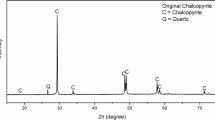Abstract
A green-coloured phyllosilicate occurring on the walls of amygdaloidal cavities and along fractures in the Deccan Flood basalts at Killari, Maharashtra, India, has been identified as iron-rich saponite with a chemical composition [Na0.60 K0.40 Ca0.47] {Mg2.05Fe3.95} (Si6.45Al1.55) O20(OH)4. In order to explore the possible application of this phyllosilicate for environmental management, we have carried out X-ray photon spectroscopic (XPS) and diffuse reflectance spectroscopic (DRS) measurements on the dichromate solutions, in both the untreated and treated form. The dichromate solution treated with the saponite samples show a remarkable capability not only to adsorb hexavalent chromium but also effect a reduction of hexavalent to trivalent chromium at an efficiency of 75%. These valence states of chromium were characterised unambiguously by XPS and DRS spectra collected at room temperature. Our studies show that Killari saponite is capable of reducing Cr (VI) to Cr (III). The ferrous saponite in Deccan Flood basalts could therefore be a useful mineral in environmental management in areas affected by Cr (VI) effluents.
Similar content being viewed by others
References
Blowes D (2002) Tracking hexavalent Cr in ground water. Science 295:2024–2025
Blowes DW, Ptacek CJ, Jambor JL (1997) In-situ remediation of Cr(VI)-contaminated ground water using permeable walls: laboratory studies. Environ Sci Technol 31:3348–3357
Chastain J (1992) Handbook of X-ray photoelectron spectroscopy. Perkin-Elmer Corporation, Foster City, Calif.
Chung YS, Lee H, Jeong HD, Kin YK, Lee HG, Kim HS, Kim S (2002) Enhanced catalytic activity of air-calcined fluorination catalyst. J Catal 175:220–225
Cuadros J, Sainz-diaz CI, Ramirez R, Hernandez-Laguna A (1999) Analysis of Fe Segregation in the octahedral sheet of bentonitic illite-smectite by means of FT-IR, 27Al MAS NMR and reverse Monte Carlo simulations. Am J Sci 299:289–308
Doyle CS, Kendelewicz T, Bostick BC, Brown GE (2004) Soft X-ray spectroscopic studies of the reaction of fractured pyrite surfaces with Cr(VI)-containing aqueous solutions. Geochim Cosmochim Acta 68:4287– 4299
Eary LE, Rai D (1988) Chromate removal from aqueous wastes by reduction with ferrous ion. Environ Sci Technol 22:972–977
Elderfield H (1970) Chromium speciation in seawater. Earth Planet Sci Lett 9:10–16
Farmer VC (1958) The infrared spectra of talc, saponite and hectorite. Miner Mag 31:829–845
Goodman BA, Stucki JW (1984) The use of Nuclear Magnetic Resonance (NMR) for the determination of tetrahedral Aluminium in Montrmorillonite. Clay Miner 19:663–667
Gu B, Chen J (2003) Enhanced microbial reduction of Cr(VI) and U(VI) by different natural organic matter fractions. Geochim Cosmochim Acta 67:3575–3582
Gupta HK, Rao RUM, Srininvasan R, Rao GV, Reddy GV, Diwedy KK, Banerjee DC, Mohanty R, Satyasaradhi YR (1999) Anotomy of surface rupture zones of two stable continental region earthquakes, 1967 Koyna and 1993 Latur, India. Geophys Res Lett 26:1985–1988
James BR (2003) Chromium in encyclopaedia of water science. Marcel Dekker, New York
Kim JG, Jung PK, Moon HS, Chon CM (2002) Reduction of hexavalent chromium by pyrite-rich andesite in different anionic solutions. Environ Geol 42:642–648
Kinsey RA, Krikpatrick RJ, Hower J, Smith K, Oldfield E (1985) Highresolution aluminum-27 and silicon-29 nuclear magnetic resonance spectroscopic study of layer silicates, including clay minerals. Am Miner 70:537–548
Kohyama N, Shimoda S, Sudo T (1973) Iron-rich saponite (ferrous and ferric forms). Clays Clay Miner. 21:229–237
Russell JD, Fraser AR (1994) Infrared methods. In: Wilson MJ (ed) Clay mineralogy: spectroscopic and chemical determinative methods. Chapman & Hall, London, pp 11–67
Taylor RW, Shen S, Tu S, Bleam WF (2000) Chromate removal by dithionitereduced clays: Evidence from direct X-ray adsorption near edge spectroscopy (XANES) of chromate reduction at clay surfaces. Clays Clay Miner 48:648–654
White AF, Yee A (1985) Aqueous oxidation-reduction kinetics associate with coupled electron-cation transfer from iron-containing silicates at 25°C. Geochim Cosmochim Acta 49:1263–1275
Wilson AD (1960) The micro-determination of ferrous iron in silicate minerals by a volumetric and a calorimetric method. Analyst 85:823–827
Wilson MJ (1994) Clay mineralogy: spectroscopic and chemical determinative methods. Chapman & Hall, London
Wong J, Angell CA (1976) Glass structure by spectroscopy. M. Dekker, New York
Acknowledgments
We are grateful to V.P. Dimri, Director, National Geophysical Research Institute, and Dr. J.S. Yadav, Director, Indian Institute of Chemical Technology, Hyderabad for their encouragement and support. We thank Dr. H.K. Gupta, Secretary, Department of Ocean Development, Government of India, New Delhi, for his enthusiastic support and also for his keen interest in the studies of the mineralogy of the Killari borehole. We thank Dr. R. Srinivasan for many useful discussions. GP is grateful to Dr. Tom Beer, Australia for his kind appreciation of this paper. We thank Dr. R. K. Chadha for inviting us to make this contribution to the special issue of Natural Hazards. We gratefully acknowledge the partial financial support by ISRO, Department of Space Government of India under the PLANEX programme. The manuscript has been improved by constructive comments from the reviewers and from Prof. W.A. Bassett, Cornell University, Ithaca, USA.
Author information
Authors and Affiliations
Corresponding author
Rights and permissions
About this article
Cite this article
Parthasarathy, G., Choudary, B., Sreedhar, B. et al. Environmental mineralogy: spectroscopic studies on ferrous saponite and the reduction of hexavalent chromium. Nat Hazards 40, 647–655 (2007). https://doi.org/10.1007/s11069-006-9015-z
Received:
Accepted:
Published:
Issue Date:
DOI: https://doi.org/10.1007/s11069-006-9015-z




